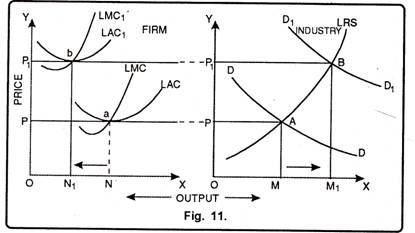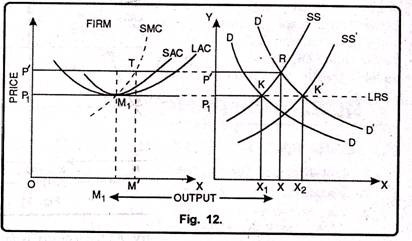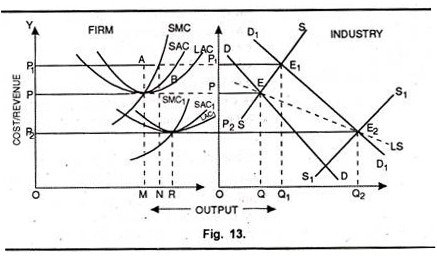Long Run Equilibrium Along with Laws of Costs of Industry!
In order to have a complete knowledge of long run equilibrium of industry, it is essential to know how price and cost adjust themselves when new firms enter the industry.
The nature of this adjustment depends on whether the industry is operating under constant cost, increasing cost or diminishing cost.
For this sake, long run equilibrium along with laws of costs of industry has been explained as under:
(i) Long Run Equilibrium in Increasing Cost Industry:
ADVERTISEMENTS:
Increasing cost industry refers to that industry in which average cost increases with increase in output. Under increasing cost industry supply curve slopes upward from left to right. It is only due to the reason that when an industry expands in response to an increase in demand it faces some economies as well as diseconomies. Therefore when external diseconomies overweigh the external economics we have an increasing cost industry which is the most typical of the actual competitive world.
In figure 11 LRS is the long run supply curve of an increasing cost industry. DD is the demand curve which cuts the supply curve at point A, thus, determines the output OM and price OP. Now, the demand increases from DD to D1D1, the price level also goes up from OP to OP1.
Since the firms are enjoying supernormal profits, new firms will enter into the industry. As the industry is facing increasing costs due to certain external diseconomies cost curves of the firms will shift upward. The output will increase from OM to OM1 and the price will also increase from OP to OP1.
In case of the equilibrium of firm, when the price is OP, the firm is in equilibrium at a. Now, demand increases from DD to D1D1, the equilibrium also shifts to b. It means OP1 price. The new firms lured by higher price and super-normal profits would continue entering the industry till all the firms are left only with normal profit. Here we must remember that with the increase of firms, the share of each firm in output will fall. This is simply due to increasing cost industry; higher level of output can be attained only at a higher price.
(ii) Long Run Equilibrium in Constant Cost Industry:
ADVERTISEMENTS:
A constant cost industry refers to that industry in which external economies as well as diseconomies are prevalent in the same measure. In that case there is no shift in the cost curves. Similarly, an industry can also be a constant cost industry if its expansion breeds neither external economies nor diseconomies.
According to Prof. Samuelson, “Only if the industry is small compared with the total of all other uses, will Marshall’s long-run supply curve be horizontal which is called the case of constant cost industry.”
Therefore, it may be concluded that an industry will be a constant cost industry if:
ADVERTISEMENTS:
(1) The expansion of an industry creates both external economies as well as diseconomies.
(2) The expansion of an industry creates neither external economies nor diseconomies.
In fig. 12 suppose the industry is in equilibrium with price OP1 and output OX1. This price is determined by the intersection of demand and supply curve. At price OP1, the firm is producing OM1 level of output. Now suppose the demand for industry’s output rises which shifts the demand curve from DD to D’D’. In the short run, price will rise to the OP’ because the new demand curve and given the short run supply curve intersect to determine the price.
At higher price OP’, the firm will produce OM’ level of output because this maximizes the profits. But higher price OP’ cannot prevail in the long run. At this price, the firms in the industry are enjoying super-normal profits. Lured by these super normal profits, new firms will enter the industry causing supply curve to shift to right. This process will continue so long as price comes to its old level i.e., OP1 at which firms get normal profits.
The short run supply curve SS will shift to its new position S’S’, intersecting the demand curve D’D’, balancing industry supply curve and demand (OX2) at price OP1. In the long run, industry supply will increase from OX1 to OX2. If we join two points K and K’, we get KK’ as the long run supply curve. Thus, in constant cost industry, in response to increase in demand, there will be an increase in equilibrium output but equilibrium price will remain unchanged.
(iii) Long Run Equilibrium in Decreasing Cost Industry:
Decreasing cost industry is influenced by external economics as they expand. Due to the effect of external economies, the set of cost curves of the firm shifts downward. In other words, there are net economies. But due to net economics, the cost curves of all firms will fall.
The net economies accrue as trained labour, cheap raw-material and other such facilities are available. So under decreasing cost industry, the additional supplies of product will be coming forth at a reduced cost and supply curve will slope downward from left to right. The fact is more clear from the diagram 13.
In fig. 13 suppose DD is the industry’s demand curve and SS is the supply curve. Both these curves intersect at point E which determines equilibrium price OP and OQ level of output Now suppose, industry’s demand increases and demand curve shifts to D1D1.
ADVERTISEMENTS:
With the increase in demand price also increases to OP1. At increased price OP1, the firms working in the industry will increase their production from OM to ON. At price OP1 firms are enjoying supernormal profits. These supernormal profits will attract new firms in the industry.
When new firms enter the industry, industry’s short run supply curve will shift to right. As a result, equilibrium price will reduce to OP2. In decreasing cost industry, entry of new firms must bring down factor prices. Fall in factor prices will cause the cost curves of the firms to shift downward. Now long run equilibrium price OP2 will be less than the initial price OP. Industry’s new equilibrium output will be OQ2. By joining the points E and E1, we get a smooth curve which is the long run supply curve under decreasing cost industry.


